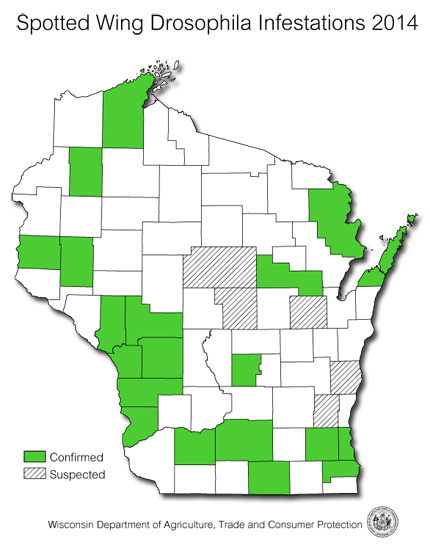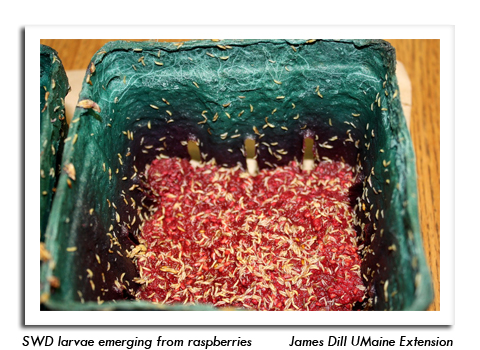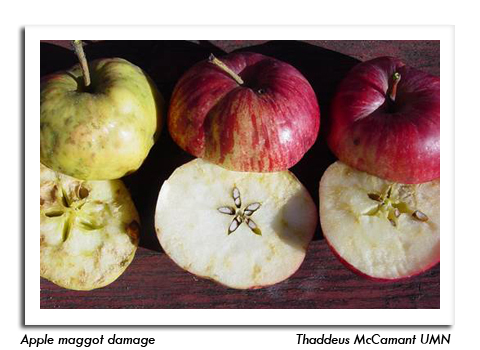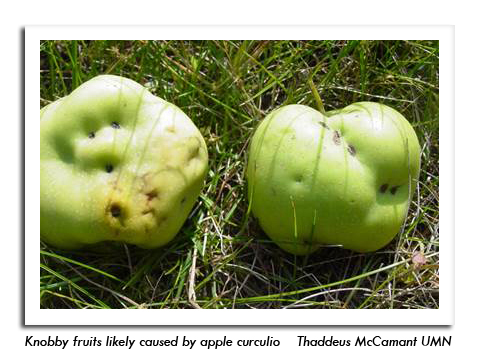
 |
|
|
Fruits
Volume 59 Number 18 Date 11/13/2014 SPOTTED WING DROSOPHILA - Larvae and adults were confirmed in 20 Wisconsin counties this season. The first flies appeared in traps from June 24-30 and infestations in fruits were prevalent by mid-July. Significant losses to raspberry and blackberry crops were sustained for the third consecutive year. Spotted wing drosophila, the fastest-spreading invasive fruit pest detected in the U.S. and Wisconsin in recent history, has been documented in 36 of the state's 72 counties since 2010 and probably occurs statewide. APPLE TREE DECLINE AND MORTALITY - Considerable damage to apple trees was apparent across the state after the winter of 2013-2014, one of the ten coldest winters on record in Wisconsin. Accounts of slow leaf emergence, leaf or flower emergence followed by collapse, and even tree death were common in mid-June, with the greatest losses occurring in northern Wisconsin. The tree decline and mortality observed by many apple growers was caused by a combination of factors, including the summer drought of 2012, a subsequent heavy fruit crop in 2013 (in response to the 2012 crop freeze) and the unusually harsh winter. Trees of all ages and varieties were impacted. APPLE MAGGOT - The first flies of the season were captured by late June. Apple maggot pressure remained low until the final week of July when counts surged abruptly to 10-38 flies per trap. Numbers fluctuated in August, increasing markedly after each heavy rainfall of 1-2 inches. Apple maggot flies persisted well into September and damage to late cultivars became evident in some orchards. CODLING MOTH - Moths began appearing in traps by May 21 and the spring biofix was set from May 26-30 at most southern and central monitoring sites. The first flight peaked during the first half of June, although spring moths continued to fly for several more weeks. A few orchards documented a distinct "B peak" in the flight around late June. Damage resulting from first generation larvae was noticeable by July 8. Emergence of summer moths began in mid-July and controls continued as required from late July throughout August. Counts remained high until early September. The latter flight was variable but generally smaller than the first at most sites. Effective codling moth management proved challenging this year due to heavy June rains and continuous moderate to high counts between the first and second flights. The rainfall reduced efficacy of larvicides and forced growers to reapply treatments, while the failure of counts to taper off between flights made it difficult to time the second biofix and the optimal treatment period for second generation larvae. APPLE CURCULIO - Localized, severe damage by this weevil was reported from a few southern Wisconsin apple orchards in 2014. The apple curculio (AC) has an appearance and life history similar to that of the plum curculio (PC), but is capable of reproducing in apples and migrates into orchards later in the season than PC. Apple curculio damage results in distinct scarring around the feeding hole which resembles tarnished plant bug and PC injury. Fruits with numerous small surface holes surrounded by a depression may be evidence of infestation. Apple growers in the state should become familiar with this emerging pest and incorporate scouting for AC into their IPM programs in 2015. EXOTIC GRAPE MOTHS - Eleven vineyards in Brown, Door, Kewaunee, Manitowoc and Sheboygan counties were systematically trapped for exotic grape moths from May 1-September 30. The target pests were the light brown apple moth, European grape berry moth, European grapevine moth, and silver Y moth, all insects of high concern to the state's emerging grape industry and considered "priority pests" for grapes by USDA APHIS. No exotic fruit moths were found. WOOD BORERS - The prevalence of winter injury, tree stress and surplus spring rain created optimal conditions for the spread of black rot in 2014. According to Orchard IPM Specialist, John Aue, apple trees weakened or dying from winter injury or black rot infection this season will be at increased risk of borer problems in coming years. The DATCP apple insect monitoring program is planning to supply lures for the American plum borer, dogwood borer and lesser peachtree borer next spring to apple insect trapping network participants interested in monitoring these pests. -- Krista Hamilton, DATCP Entomologist 





|
|
|